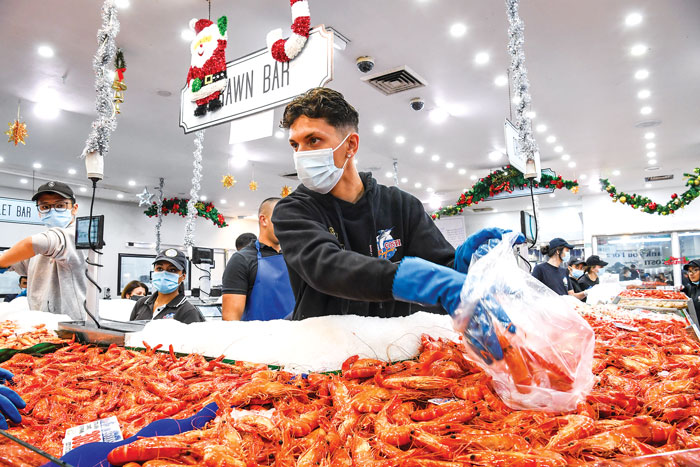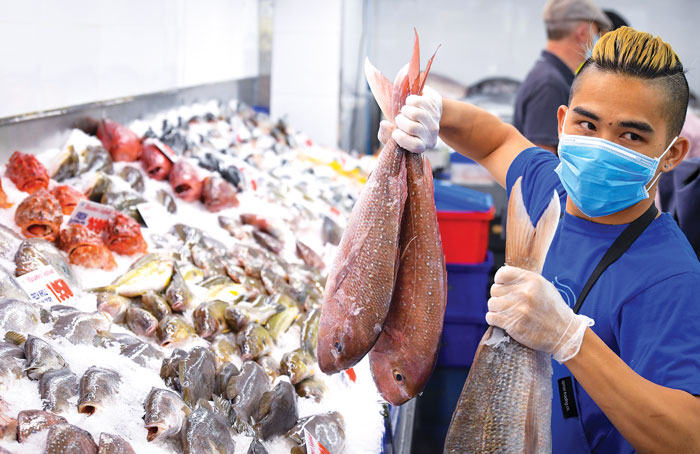Strong demand for local seafood and the continued digital evolution of the fishing sector are among the positives emerging for the industry from the COVID-19 pandemic in Australia
By Melissa Merino and Catherine Norwood
In 2020, when COVID-19 first emerged in Australia, the FRDC’s special editions of FISH magazine looked at some of the impacts the pandemic was having on the diverse stakeholders in the seafood sector. At the end of 2021, with vaccination rates up and even the hardest hit states reopening, FISH revisits some of those we spoke with last year to see how they have fared in year two of the pandemic.

Digital acceleration
At Sydney Fish Market (SFM) the pandemic has accelerated the move to digital trading in several ways. During restrictions in 2020, SFM first introduced remote bidding for its live fish auctions, a move that proved even more important in 2021, with lockdowns in Sydney.
Fewer buyers were able or willing to attend the market, with specific local government areas locked down and travel limits in place. Even those who did attend auctions in person used remote bidding because of restrictions on the auction floor.
SFM Executive Manager, Seafood Trading Gus Dannoun says the success of the remote-bidding system made buyers realise what was possible and has laid the groundwork for a new digital trading platform. SFM will integrate its operations with the agri-trading platform ShoreTrade, with an exclusive agreement for use of the platform for the fisheries sector in Australia and New Zealand.
It expects to launch its new digital trading platform in early 2022, providing a 24/7 business-to-business digital seafood marketplace in conjunction with its live auctions.
The platform functions will include presale ordering and supply, fixed-priced selling for fishers and availability alerts for targeted species for buyers.
SFM expects the platform to help stabilise the market and help the industry deal with the unexpected, such as COVID-19, by providing multiple trading opportunities without sole reliance on the physical auction.
COVID-19 was, in fact, responsible for the first ever cancellation of SFM’s live auction in its 55-year history when a security guard tested positive. Dannoun says it was fortunate the guard had limited contact with other staff and only one day’s auction was affected.
In response, SFM has introduced its own onsite tracking system for all staff and visitors taking part in auctions, to accelerate contact tracing, should a similar event occur. The Contact Harald tracing system will initially operate for six months, with all staff and visitors involved in the auction process wearing bluetooth-enabled lanyards while on site.
While cafés and restaurants at SFM have been closed, retailers have continued to operate with a significant growth in online ordering and home delivery services, such as GetFish, operated by De Costi Seafoods. Dannoun expects there will be an ongoing demand for these services following the lifting of restrictions.
He reports prices for seafood have continued to rise. In the first quarter of 2020–21, prices were six to 10 per cent higher than for the same period the previous year, an exceptional result. In the first quarter of 2021–22, prices were again two per cent higher than the same period the previous year.

Human dimensions
While domestic demand for seafood has held up, and businesses have adapted to new online markets, the people within the seafood industry have been feeling the pinch of COVID-19 in 2021, says Melbourne Seafood Centre CEO Barbara Konstas.
“A lot of people moved out of the industry and staffing levels have dropped away. If you have someone exposed to COVID-19, you can’t get staff to replace them. If your filleter goes down, you can’t just pluck another one from thin air. It’s a specialty.”
In Victoria, she says, 2021 has been personally harder for people in the seafood industry than 2020, even if business has remained strong.
“Buyers are still making the sales but businesses are made up of people, and there’s a malaise, an actual fatigue with COVID and the lockdown in Victoria.
“People are really thankful they are working, but they are tired. We’re about to go onto our busiest period at Christmas and usually you’ve had a winter break, but that hasn’t been possible.”
While restaurant closures through 2020 and 2021 have seen a decline in demand for some top-end products, there is growing demand for other products, especially from domestic buyers.
“More people are wanting to eat local, Australian product,” Konstas says. “This is what COVID has given back – that sense of nationalism. Local sales have picked up off the back of greater awareness of Australian produce.”
While she says some new business models and online platforms will stick, she believes there is still a big appetite for personal contact.
Social strategies
Northern Territory Spanish Mackerel fisher Norm Hedditch is one of many who has turned to social media to help boost sales during the pandemic.
In 2020, his business Taroona Pty Ltd expanded its retail and freezer capacity in Darwin, selling only wild-caught NT product. Radio advertising paid off, but more recently he has increased his social media presence to communicate directly with customers.
“We’ve got a Facebook page and Instagram. My daughter runs it all and that’s definitely helped to get the word out. As soon as we’ve got new product in, we’ll do a post. She’ll video me holding a new box of prawns saying ‘here, straight off the boats, this week we’ve got these packs of banana prawns’ or whatever has just come in, including our own cryovacked product.”
In 2020, prices for Hedditch’s premium, line-caught Spanish Mackerel dropped from $13 per kilogram to a “borderline” $9 following restaurant closures in his usual markets of Melbourne and Sydney.
But since then, he says the Melbourne market has staged a remarkable recovery, even as restaurants have remained closed for in-house dining – his product is selling for $2.50 per kilogram more than its previous highs. Hedditch credits his trading partner Mackay Reef Fish Supplies and the reputation of his premium quality produce.
He says the NT has been lucky to remain largely COVID-free through 2021, and ‘grey nomads’ travelling through have helped to boost the local economy. “Our tourism has survived quite well, although some industries, like charter boats, are struggling,” Hedditch says.

Missing restaurant trade
While Tasmania has also remained comparatively free of COVID-19 in 2021, the impacts of outbreaks elsewhere continued to affect the state’s seafood sector.
Tasmanian Seafood Industry Council (TSIC) Chief Executive Julian Harrington says the diversity of the industry has led to a similarly mixed bag of impacts for the state’s commercial fishing and aquaculture sectors.
The closure of restaurants in Victoria and New South Wales continued to hit hard those who relied on the hospitality trade. Sales of live fish, such as Banded Morwong and wrasse sent to Chinese restaurants, were affected by both reductions in international visitors and the closure of restaurants.
“There are also questions around what the hospitality sector will actually look like in the future, as several high-profile Chinese restaurants have ceased trading during the year,” says Harrington.
Sales of oysters, which predominantly go to restaurants, have also been highly variable, in response to the opening and closing of markets in NSW and Victoria. But fishers and processors with strong markets in other states have continued to do well.
He highlighted Tasmanian Government initiatives helping to support the industry, including grants for processors diversifying into new products and markets. He expects more frozen products with an extended shelf life will be part of value-adding initiatives.
TSIC is also working with the Tasmanian Department of State Growth to investigate potential markets and the appeal of Tasmanian-branded seafood to different consumer demographics in other states. This will help build an evidence-based approach to future marketing initiatives, to develop new markets and underpin the resilience of the industry in the future.
Strong local demand
In Western Australia, there is strong demand for local seafood and Western Australian Fishing Industry Council (WAFIC) CEO Darryl Hockey says everything being caught is selling well. The Western Rock Lobster industry has faced some export marketing challenges but has managed to keep its products moving through diversified trade channels.
The initial flood of product onto the local market following the COVID-19 trade impacts saw prices plummet and local demand surge, particularly through the innovative back-of-boats sales initiative. As export trade rebuilt and the prices strengthened, it has been encouraging to see ongoing loyalty displayed by local consumers.
WAFIC is working with local producers to promote some of the lesser known species, with growing demand for Akoya Pearl Oyster, Australian Sardine, Australian Salmon, Sea Mullet and Ocean Sand Crab.
Hockey says consumers seem to have become more willing to experiment with more diverse species and dining styles, which will help to take pressure off more popular species.
The pandemic has also generated greater awareness around food security and support for local seafood, strengthening calls for mandatory country-of-origin labelling in the WA food service industry – similar to the system operating in the NT – so consumers can be confident they are buying local products. While there is mandatory country-of-origin labelling in the retail sector, the NT is the only jurisdiction with similar regulations in the food service sector.
With international and many interstate borders closed, there has also been an unprecedented surge in recreational fishing and local tourism in WA. Shortages of fishing equipment, including boats, have been reported nationally. With so many people fishing, Hockey says it highlights the need to manage the recreational fishing levels, which are well above the recovery benchmarks required for the sustainability of prized high-profile indicator species such as West Australian Dhufish, Snapper and Baldchin Groper.
New markets
Eric Perez, CEO of the Queensland Seafood Industry Association, has also seen the rising demand for local seafood throughout the pandemic, which has helped to offset the fall in demand from interstate buyers.
Perez says there have been ongoing and significant impacts on the export of live seafood, such as live coral trout, as well as on sales in Sydney and Melbourne.
Some commercial fishing businesses moved to diversified direct-to-public sales channels, as well as finding new markets. These strategies are among many that have been adopted to engage with local communities, he says.
For those who have moved to direct sales to the public, using social media and the ability to establish some kind of outlet or ‘presence’ have proved to be critical factors in their success.





